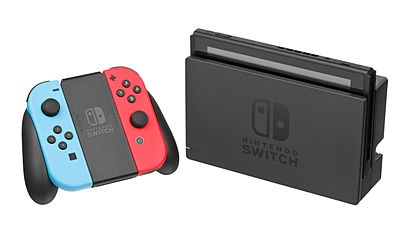Nintendo Switch OLED facts for kids
 |
|
|
|
| Also known as |
|
|---|---|
| Developer | Nintendo PTD |
| Manufacturer |
|
| Product family | Nintendo Switch |
| Type | Video game console |
| Generation | Eighth |
| Release date |
|
| Retail availability | 2017–present |
| Introductory price | |
| Units shipped | 114.33 million (as of September 30, 2022[update]) (details) |
| Media |
|
| Operating system | Nintendo Switch system software |
| Power |
|
| System-on-chip used | Nvidia Tegra X1/Tegra X1+ |
| CPU | ARM 4 Cortex-A57 cores @ 1.02 GHz |
| Memory | 4 GB LPDDR4 @ 1331/1600 MHz |
| Storage | 32 GB/64 GB eMMC |
| Removable storage | microSD/HC/XC (up to 2 TB) |
| Display | |
| Graphics | 256 Maxwell-based CUDA cores |
| Sound |
|
| Input | Volume +/−, power buttons |
| Controller input |
|
| Camera | Ambient light sensor |
| Touchpad | Multi-touch capacitive |
| Connectivity |
|
| Online services |
|
| Dimensions |
|
| Weight |
|
| Best-selling game | Mario Kart 8 Deluxe (48.41 million, as of September 30, 2022[update]) |
| Predecessor | Wii U |
| Related articles | Nintendo Switch Lite |
The Nintendo Switch is a super cool video game console made by Nintendo. It was first released around the world on March 3, 2017. The Switch is special because it's a "hybrid" console. This means you can play it like a regular home console connected to your TV. Or, you can take it with you and play it like a portable handheld device!
The Nintendo Switch has wireless controllers called Joy-Cons. They have buttons, joysticks, and can even sense motion. These Joy-Cons can attach to the sides of the console for playing on the go. You can also connect them to a special grip to make them feel like a traditional game controller. Or, you can use them separately in your hands, like the Wii Remote, which is great for playing with friends. The Switch lets you play games online with others. You can also connect to other Switch consoles nearby without the internet. Games for the Nintendo Switch come on small game cards or you can download them digitally from the Nintendo eShop. Good news: the system doesn't have a "region lock," so you can play games from anywhere in the world!
Contents
What is the Nintendo Switch?
The Nintendo Switch was first shown to the public on October 20, 2016. During its development, it was known by the secret name NX. Nintendo created the Switch because their previous console, the Wii U, didn't sell very well. They also wanted to compete with popular mobile games.
How the Switch Was Designed
Nintendo's president at the time, Satoru Iwata, wanted the company to try new things. He pushed for mobile gaming and new types of hardware. The Nintendo Switch was designed so that many different kinds of players could enjoy it. It uses common electronic parts, like a special chip from Nvidia called Tegra. This makes it easier for game makers to create games for the Switch. It also helps games work well with existing game engines.
Games for Everyone
The Wii U had trouble getting other companies to make games for it. This meant it didn't have a lot of games. Nintendo learned from this. For the Switch, they worked hard to get many different game developers and publishers to create games. This included big companies and smaller independent game studios. Nintendo thought there would be about 100 games in the first year. But by the end of 2017, over 320 games were available! These games came from Nintendo itself, other big companies, and indie developers.
Nintendo Switch Models
Nintendo has released a few different versions of the Switch:
- Original Nintendo Switch: This is the first model that came out in 2017. It can connect to your TV or be played handheld.
- Nintendo Switch Lite: This version was released on September 20, 2019. It's smaller and lighter, and it's made only for handheld play. You can't connect it to a TV.
- Nintendo Switch – OLED Model: This is a newer, improved version of the original Switch. It came out on October 8, 2021. It has a bigger, brighter OLED screen, which makes games look even better. It also has better sound and a new dock with a wired internet port.
How Popular is the Nintendo Switch?
The Nintendo Switch is an eighth-generation console. This means it competes with consoles like Microsoft's Xbox One and Sony's PlayStation 4. It also competes with newer consoles like the Xbox Series X and Series S and PlayStation 5.
Sales Success
The Switch was very popular right away. In its first month, nearly three million consoles were sent to stores. This was more than Nintendo expected! Within a year, over 14 million units were sold worldwide. This was more than the total sales of the Wii U during its entire lifespan. By early 2018, the Switch became the fastest-selling home or hybrid console in both Japan and the United States.
Top-Selling Games
As of September 2022, all Nintendo Switch models combined have sold over 114 million units worldwide! This makes it Nintendo's best-selling home console ever. It's also the fifth-best-selling game console of all time. Many of Nintendo's own games have sold incredibly well on the Switch. Six games have sold over twenty million copies each:
- The Legend of Zelda: Breath of the Wild
- Mario Kart 8 Deluxe
- Super Mario Odyssey
- Super Smash Bros. Ultimate
- Pokémon Sword and Shield
- Animal Crossing: New Horizons



